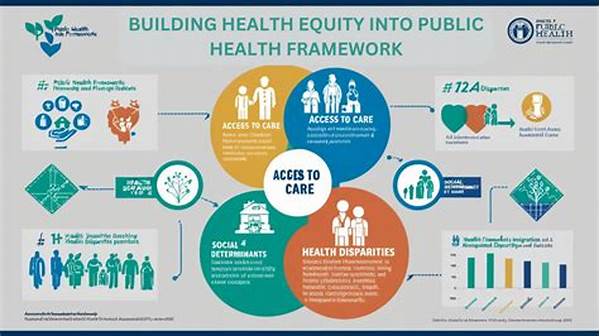Public health policy frameworks serve as essential structures for conceptualizing, implementing, and evaluating policies aimed at enhancing community health outcomes. These frameworks play a pivotal role in guiding policymakers, health professionals, and stakeholders in addressing complex public health challenges. By systematically outlining strategies, these frameworks ensure a coherent approach to promoting population health and well-being.
Read Now : Journal-specific Formatting And Submission Rules
The Importance of Public Health Policy Frameworks
Public health policy frameworks are critical in shaping effective public health interventions. They provide a structured approach to identifying, analyzing, and addressing health issues within a population. By offering a clear set of guidelines, these frameworks assist policymakers in designing targeted interventions that are both evidence-based and sustainable. Moreover, public health policy frameworks facilitate a coordinated response amongst various stakeholders, ensuring that efforts are not duplicated and resources are efficiently utilized. These frameworks often incorporate the latest scientific research, best practices, and lessons learned from previous public health initiatives. Consequently, they are instrumental in achieving long-term health goals, such as reducing the prevalence of chronic diseases, controlling infectious diseases, and promoting health equity. The adaptability of public health policy frameworks allows them to be tailored to the specific needs and circumstances of different populations, enhancing their effectiveness in diverse settings.
Core Components of Public Health Policy Frameworks
1. Problem Identification: Effective public health policy frameworks begin with a thorough assessment of health issues impacting a community.
2. Evidence-Based Strategies: They emphasize integrating scientific evidence to inform decision-making processes.
3. Stakeholder Engagement: These frameworks advocate for collaboration and input from all relevant parties, including government, healthcare providers, and the community.
4. Implementation Plan: A detailed strategy for executing identified interventions is crucial to ensure they reach the intended audience.
5. Evaluation and Monitoring: Regular assessment of outcomes and impacts to gauge success and inform necessary adjustments.
Developing Public Health Policy Frameworks
The development of public health policy frameworks involves meticulous research and strategic planning. Policymakers must first gather and analyze data to identify prevailing health issues and prioritize them based on factors such as severity, prevalence, and the potential for intervention. Following this, evidence-based strategies are formulated, integrating scientific insights with practical considerations. The involvement of stakeholders from the onset not only enriches the process with diverse perspectives but also fosters a sense of ownership and commitment to the implemented strategies. Additionally, public health policy frameworks must incorporate robust evaluation mechanisms to measure their impact effectively. Adjustments informed by evaluation results are essential for continuous improvement and ensuring frameworks remain relevant in changing health landscapes.
Key Challenges in Implementing Public Health Policy Frameworks
Implementing public health policy frameworks can present several challenges:
1. Resource Constraints: Limited funding and resources can hinder the implementation of comprehensive frameworks.
2. Political Dynamics: Political environments may affect policy priorities and the allocation of resources.
3. Cultural Sensitivity: Frameworks must be adaptable to cultural contexts and beliefs to gain public acceptance.
Read Now : Guidelines For Research Quality Standards
4. Data Limitations: Inadequate or unreliable data can impede accurate problem identification and intervention design.
5. Intersectoral Coordination: Achieving collaboration across different sectors is often complex, requiring effective communication and partnership strategies.
6. Technological Barriers: Insufficient infrastructure may limit the deployment of technological solutions.
7. Resistance to Change: Stakeholders may resist new policies due to entrenched interests or skepticism.
8. Monitoring and Evaluation Gaps: Incomplete evaluation processes can obscure the understanding of a framework’s effectiveness.
9. Global Health Dynamics: Cross-border health issues necessitate international cooperation and alignment of frameworks.
10. Equity Considerations: Ensuring frameworks address health inequalities can be challenging but is crucial for achieving broad-based improvements.
Best Practices for Public Health Policy Frameworks Development
The development of public health policy frameworks is a meticulous process that demands careful planning, collaboration, and strategic foresight. Best practices involve adopting a comprehensive approach that combines robust data collection with stakeholder engagement at all levels of governance. Central to developing effective frameworks is conducting thorough needs assessments that prioritize community-specific health concerns. A focus on leveraging scientific and empirical evidence ensures that the interventions are both effective and sustainable. Furthermore, facilitating intersectoral collaboration is paramount, as it galvanizes diverse expertise and resources from different sectors towards shared health objectives. Policymakers must also integrate mechanisms for regular evaluation and feedback to monitor progress and adapt strategies to emergent health trends and challenges. This evolving approach allows public health policy frameworks to remain relevant and impactful across diverse demographic and geographic contexts.
Conclusion
In summary, public health policy frameworks are integral to the systematic development of effective public health policies. They offer structured methodologies for addressing health challenges, integrating evidence-based strategies, and ensuring collaborative efforts across multiple sectors. Despite potential challenges in implementation, these frameworks provide the foundation for achieving sustainable improvements in population health. As the public health landscape continues to evolve, the adaptability and strategic application of these frameworks remain critical in promoting and protecting the well-being of communities worldwide. Stakeholders must remain committed to refining and innovating these frameworks, ensuring they continue to serve as robust tools for advancing global health objectives.
